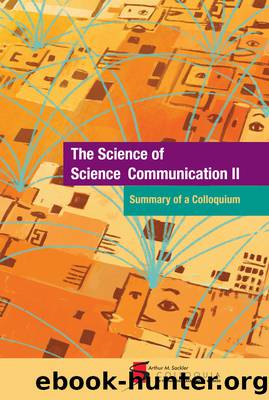The Science of Science Communication II: Summary of a Colloquium by Arthur M. Sackler Colloquia of the National Academy of Sciences

Author:Arthur M. Sackler Colloquia of the National Academy of Sciences
Language: eng
Format: epub
Publisher: The National Academies Press
Published: 2014-01-23T00:00:00+00:00
HOW SCIENTISTS TALK TO ONE ANOTHER ABOUT THEIR SCIENCEâAND WHAT THE PUBLIC HEARS
How do scientists actually communicate with each other, asked Kevin Dunbar, professor of human development and quantitative methodology at the University of Maryland in College Park. In the past they have used letters, journal articles, books, and presentations, while today they also have access to e-mail, Facebook, Twitter, and other new communication platforms. But all of these media have been built by humans as aids to the way the human brain works.
Analogies and Brain Activity
Dunbar and his colleagues have been studying communication in laboratory meetings in the United States and in Italy to learn exactly how scientists interact in those settings. They audiotaped and videotaped the meetings and interviewed the scientists before and after the meetings. For physician-scientists, they also compared interactions with patients to interactions with other scientists.
One prominent finding was that scientists relied frequently on analogies. They used local analogies within domains to fix problems, regional analogies with nearby domains to generate hypotheses, and long-distance analogies across domains to conceive of explanations, with their goals dictating the kinds of analogies they use.
Dunbar and his colleagues also have been using brain scans to identify parts of the brain that are more active when making an analogy. For example, the farther an analogy is from the source concept, the more active is a particular part of the brain known as the front polar cortex.
Using Analogies Effectively
Dunbar also has been involved in brain-scanning experiments where subjects are given data that are consistent or inconsistent with a hypothesis. Data that are consistent with a hypothesis generate activity in particular parts of the brain, while data that are inconsistent do not.
The use of analogies makes a difference in laboratory interactions. Laboratories where members have similar backgrounds, such as a laboratory where everyone is a microbiologist, tend to have greater difficulty using analogies effectively. In contrast, laboratories where members have different backgrounds, such as a laboratory that combines physicists and chemists, can use analogies more readily to make discoveries.
Gender Analyses
Finally, Dunbar briefly mentioned that female scientists and male scientists do not differ in their use of analogical reasoning and social interactions. However, men were more likely to assume that they knew the cause of unexpected findings, whereas women were more likely to set out to determine the cause of such findings.
Using Stories to Communicate Science
Dunbarâs observations are a powerful argument for interdisciplinarity in science, said Green. They also shed light on how narratives can be used to reach particular types of audiences. Nonscientists often say that they cannot deal with math or that physics is too hard, but they do not say that they cannot deal with stories. Both analogies and narratives can make science more accessible to such individuals. At the University of North Carolina, for example, a program called âScientists with Storiesâ is training scientists in storytelling techniques to help them better communicate their science while also helping them look for the stories in their own research.
Green also cited the
Download
This site does not store any files on its server. We only index and link to content provided by other sites. Please contact the content providers to delete copyright contents if any and email us, we'll remove relevant links or contents immediately.
Spell It Out by David Crystal(35854)
Life for Me Ain't Been No Crystal Stair by Susan Sheehan(35539)
Cecilia; Or, Memoirs of an Heiress — Volume 1 by Fanny Burney(32075)
Cecilia; Or, Memoirs of an Heiress — Volume 3 by Fanny Burney(31469)
Cecilia; Or, Memoirs of an Heiress — Volume 2 by Fanny Burney(31419)
The Great Music City by Andrea Baker(30796)
Professional Troublemaker by Luvvie Ajayi Jones(29425)
We're Going to Need More Wine by Gabrielle Union(18641)
Twilight of the Idols With the Antichrist and Ecce Homo by Friedrich Nietzsche(18307)
The Secret History by Donna Tartt(18211)
All the Missing Girls by Megan Miranda(14785)
Cat's cradle by Kurt Vonnegut(14777)
Pimp by Iceberg Slim(13797)
Bombshells: Glamour Girls of a Lifetime by Sullivan Steve(13698)
Fifty Shades Freed by E L James(12924)
Talking to Strangers by Malcolm Gladwell(12888)
Norse Mythology by Gaiman Neil(12860)
The Social Justice Warrior Handbook by Lisa De Pasquale(11957)
Underground: A Human History of the Worlds Beneath Our Feet by Will Hunt(11846)
